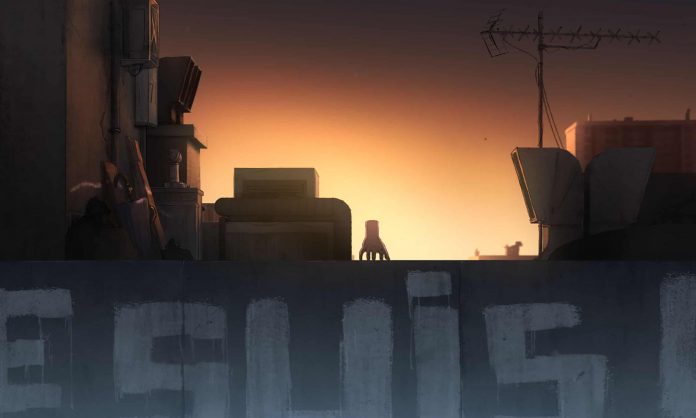ARTNEWSPRESS: A disembodied hand searches for its former owner in this haunting French gem that signals the arrival of a major new talent in animation
While the Christmas box-office charts are likely to be dominated by Disney’s family-friendly sing-along sequel Frozen II, anyone looking for something more adventurous in animation should seek out this remarkable French gem, which gets a limited UK cinema release before coming to Netflixon 29 November.
A tale of broken hearts and body parts, it has been freely adapted from the book Happy Hand by Guillaume Laurant (who was Oscar-nominated for his script work on Jean-Pierre Jeunet’s Amélie), and became the first animated feature to take the top prize in the Critics’ Week section at Cannes, before scoring further significant wins in Sitges, Strasbourg, and at the Annecy international animated film festival. Nimbly entwining a tender love story with the macabre grip of a body-horror movie, this feature debut from co-writer/director Jérémy Clapin builds on the success of his acclaimed shorts Une histoire vertébrale (2004), Skhizein (2008) and Palmipédarium (2012), confirming the arrival of a major new voice in international animation.
Like Thing from The Addams Family, or a benign relative of the titular appendages from The Hands of Orlac, I Lost My Body finds a severed hand coming to life in a Parisian medical lab. Having broken free of its surgical bonding, the hand learns to crawl, then walk, then run, scampering like a frightened animal from sterile captivity into the hurly-burly of the world outside. It’s a terrifying place, full of thunderous traffic, crushing machinery and rapacious rodents, all encountered as the hand scrambles over rooftops, through streets, and down into the subways, searching for its former self.
Meanwhile, a second flashback narrative plays out in parallel; tactile memories of the hand’s life when its lost body was whole. That body belongs to Naoufel, a pizza-delivery boy struggling to meet his deadlines who becomes mesmerised by the disembodied voice of Gabrielle (a disgruntled customer) on a tower-block intercom. As the kaleidoscopic narrative spirals back further still, we see Naoufel as a child in Morocco, laughing in the company of his parents, capturing the sounds of his world on a beloved cassette-recorder – sounds that will become symbols of a lost innocence and a fractured childhood.
Themes of dismemberment – physical, emotional, temporal – run throughout this beautifully haunting tale as it effortlessly interweaves the real and the surreal, the spoken and the silent. Wisely casting aside the narrative voice of the dismembered hand from Laurant’s source novel, Clapin manages to convey huge amounts of emotional information through the simple movement of fingers, creating a fully rounded (and, crucially, entirely sympathetic) character whose sensory experience of the world is eloquently expressed through gesture and mime.
What’s most impressive about I Lost My Body, which producer Marc du Pontavice (who cites Studio Ghibli co-founder Isao Takahata as an inspirational influence) envisaged as “a feature-length animated film for adolescents and adults”, is the way it marries disparate tones and formats. On the surface the story seems inflected by horror, and there are several moments that will send a shiver down your spine – the accidental strangling of a pigeon trying to protect its eggs, for example; or an attack by ferocious rats in the bowels of the metro. There are pulse-racing action sequences too, as the hand scuttles through crowded streets, and grasps on to the underside of a speeding train.
Yet the primary tone is gentle and melancholic – an almost existential evocation of memory, and the longing to be made whole. An early sequence in which the hand clambers up the ribcage and skull of a display skeleton (watched by a soon-to-be-squished eyeball!) sees gallows humour turn to something more awe-inspiring when it escapes on to a high window ledge to survey the horizon. I was unexpectedly reminded of an illustrated edition of Hans Christian Andersen’s The Shepherdess and the Chimney Sweep that I owned as a child – an image of the betrothed figurines gazing out at the magnitude of the world beyond them, filled with a terrible sense of wonder, dread, and infinite sadness.
Just as the themes of I Lost My Body dextrously juggle light and shade, so the film seamlessly blends 2D and 3D-animation techniques with elements of rotoscoped live-action to create what Clapin calls “an animated world halfway between the tangible and the imaginary”. It’s an impressive feat, reminiscent of Dutch animator Michaël Dudok de Wit’s combination of analogue and digital processes on The Red Turtle, producing something that maintains a granular, hand-drawn texture while embracing the possibilities of new technology.
A gorgeous electronic score by Dan Levy completes the picture, emphasising the romantic themes of longing and loss, tugging upon our heartstrings without resort to sentimentality.
https://theguardian.com
Mark Kermode
























